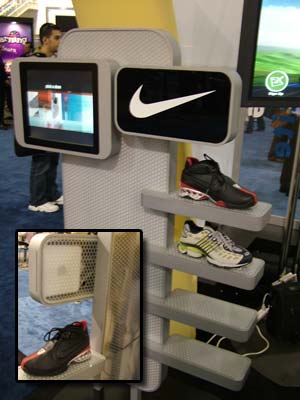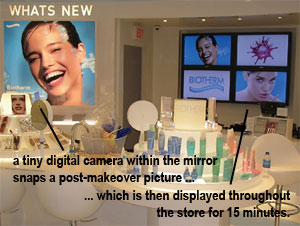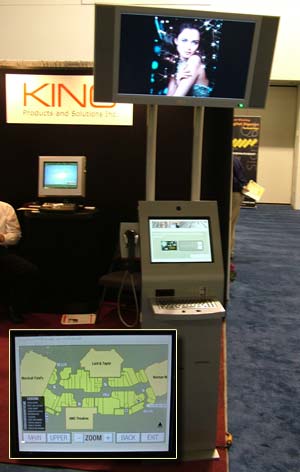Article
The future Â… on display
The second annual Digital Retailing Expo offered some big, vibrant new ideas in the realms of digital display and interactivity. Retail has never looked brighter or more colorful.
May 22, 2005 by James Bickers — Editor, Networld Alliance
The floor of Chicago's Navy Pier Exhibition Center has probably never looked more invitingly futuristic, more adventurous and colorful than it did last week when the second annual Digital Retailing Expo opened its doors. More than 80 exhibitors were on hand with their most eye-popping, foot-stopping offerings.
 |
Solaris Labs' eye-catching UrbanFace large-screen interface |
One of the biggest "wow factors" of the entire show was settled right inside the main entrance. Much has been made of the wall-sized interface used by Tom Cruise in the film Minority Report.Solaris Labs' UrbanFace interface, which allows users to move icons and folders across a giant screen, is an almost pixel-perfect capture of that movie's jaw-dropping opening sequence. Putting such a showstopper at the entrance must have given other exhibitors pause; like a young band asked to take the stage right after the Rolling Stones, they might have wondered to themselves, "how do we follow that?"
 |
GFX Dynamics offered an immersive retail simulation, with RFID and touchscreens tying customer and product information together. |
They needn't have worried, however, because there were plenty more "wows" to go around. More sublime but just as revolutionary was the elaborate clothing store model being shown by Illinois-based GFX Dynamics. The company used its floor space wisely, simulating an actual retail clothing store, with dynamic displays integrated throughout. Customers sign in on a 42-inch plasma screen, so that their preferences can be stored. Signage throughout the "store" responds to RFID tags clipped to each and every product. The digital signs themselves ranged from simple in-wall units to aesthetically pleasing clusters of three vertically stacked monitors.
Two other companies had particularly visionary integrations of digital display into traditional retail fixtures. Nebraska-based Nanonation was on hand with a number of retail offerings, many of them based around the Mac mini computer.
"The mini as a platform is incredible," said president and chief executive officer Bradley Walker, who is enamored of the $499 powerhouse computer. "For that price point, you can do native 1080i HD, right out of the box."
 |
Nanonation's display for Nike is powered by a Mac mini - small enough to hide within the fixture's already small footprint. |
Nanonation was showing two striking uses of the mini, one of which saw the tiny computer powering a large HD display unit. A custom-made fixture allowed the mini to hang below the monitor - connected by just two cables, one for power, the other for data. According to Walker, this was just for show - in a real-world application, the mini would be carefully hidden behind the display.
The other use involved Nanonation's floor display for Nike shoes. A peek around the back revealed the mini, with its tiny 6.5-inch-square footprint, tucked neatly inside the already small cabinet.
New York's DSI Group, whose history designing retail fixtures dates back long before its 1998 purchase of Media Vision brought it into digital, had one of the more sublimely creative uses of digital signage at the show. In a custom project for cosmetic retailer Biotherm, the company built a comprehensive data management system to handle the data that is generated by - and should be harvested from - complementary in-store makeovers.
 |
A look at DSI Group's innovative installation for California cosmetics retailer Biotherm |
According to company vice president Marc Weshler, one of the main problems facing cosmetic retailers is that patrons who sit for a makeover seldom pay attention to the products being used, making reorders virtually impossible. "Maybe (the customer) lost the bottle, or never, in fact, bought the bottle," he said, "but she went home and everybody said `You look great!' Now, all of that information is stored."
The display component comes when the makeover is finished. A tiny digital camera, embedded in the customer-facing mirror, snaps a picture of the "finished product" - then displays that picture on monitors throughout the store for 15 minutes. "So there's your 15 minutes of fame," Weshler laughed. He said that the system is up and running in the flagship Biotherm store in Glendale, Calif., and six additional stores are slated to go online in 2005.
 |
King Products' latest Plynth2 unit marries rugged kiosk with 30-inch display, aimed at mall and retail wayfinding applications. |
Longtime kiosk innovators King Products and GestureTek were both on hand with innovative new offerings. King Products' rugged new Plynth2 implementation pairs a 30-inch digital display with a metal kiosk enclosure and durable keyboard. The model being demonstrated at the show was designed for mall use, and included detailed wayfinding, store search capability and touchscreen map interaction.
GestureTek, a company that specializes in innovative (largely touchless) interfaces, showed its signature GestPoint interface, as well as the eye-catching GroundFX projection system, which places advertising messages beneath the customer's feet. The company was also showing its eye-catching but as-of-yet-unnamed "illuminated kiosk," an entirely translucent model that uses rear projection to place images on a thin screen. Infrared light beams up from below, capturing customer movement information and giving the lightweight unit touchscreen capability.
Canada's SMART Technologies Inc. had two eye-catching applications on display. First was a bright interactive directory for Seattle's Design Center, housed in a gorgeous natural wood cabinet.
 |
The DVD Station, on display at the SMART Technologies booth, allows customers to browse titles in a number of ways - then purchase movies in the format they prefer. |
The result of SMART's partnership with DVD Station also was on display, a 60-inch touchscreen that brings an interactive DVD browse-and-buy application to life. "We wanted to build something that is browsing-centric," said DVD Station vice president William Fischer. "Most interactive systems of this type are search-centric."
Customers using the DVD Station can browse by genre, search by title or keyword, or browse from one title to the next via suggestive marketing - click on Jerry Maguire, for instance, and you might see other films about sports, or other films starring Renee Zellweger.
"There's a reason Renee Zellweger gets $12 million per movie - she has a large, established fan base," Fischer said. "This system lets you search by Renee Zellweger. Browse at a regular video store, and you can't do that."
When it comes time to checkout, the system offers a number of options - rent, buy it new, or buy it used. According to Fischer, the next iteration of the technology will offer the option to download a film to a portable device like the PlayStation Portable.
What did you think was the "best in show"? Talk about it on our discussion boards.










